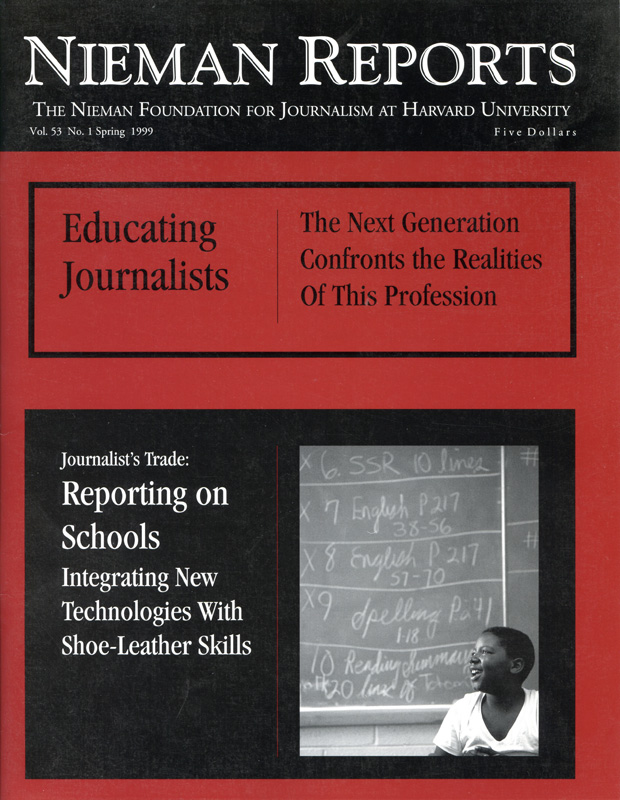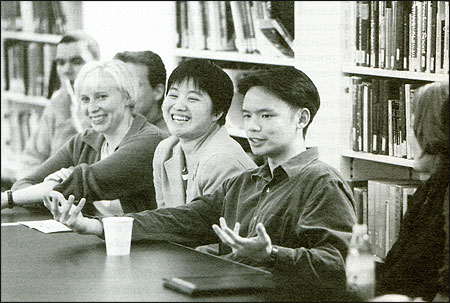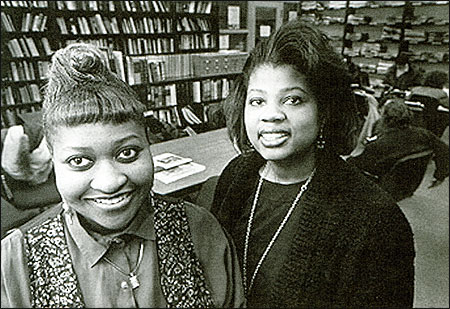
Educating Journalists
In asking young journalists to write about their experiences, what we wanted to provide was a forum in which they could express their views, concerns and ideas about the way in which journalism is practiced today. What we found as their articles arrived is that these young journalists raise questions that are relevant for seasoned journalists to ponder. As one correspondent writes: “I know in the future…I’ll take opportunities to listen to interns and recent college graduates who other folks in the newsroom might dismiss as starry-eyed idealists. I hope that listening to their perspectives will help me remember why I chose to become a journalist in the first place.”

Students from the Graduate School of Journalism at the University of California, Berkeley. Photo by Jim Vestal.
As a campus newspaper advisor, I felt defeated. The student newspaper editors had just rejected a promising black journalism student’s coverage of a West African film festival she’d attended, and Helena Victorin was quitting the paper. She resigned herself to looking for jobs in public relations after graduation instead. She vowed this was the last humiliation she would allow herself to endure after struggling for years to become a respected member of the newspaper staff.
Just the month before I had been elated for her when she learned that the college would pay for her to accompany its own internationally acclaimed African-American film professor, Claire Andrade-Watkins, to Burkina Faso, to the Pan-African film festival, an event that attracted Robert Redford, Spike Lee and other innovative and successful filmmakers from around the world.
Now, the Emerson College editors’ refusal to publish her pieces as “not newsworthy or of interest to the general student body” was a blow to both of us. As advisor to this campus weekly from l989 to 1996, I had been exploring questions of how to foster diversity at the student newspaper. This small communications college was bubbling with a growing population of talented, lively minority students eager to prepare for careers in film, television, theater, print and broadcast journalism. They brought richness of culture, ideas and perspectives from everywhere—African-Americans, Latinos and Asians from all over the United States, Puerto Rico and Central America, many of them children of immigrants from Jamaica, Barbados, Haiti, Dominican Republic, Nigeria, Cameroon and South Africa.
My work as a former journalist had taught me that these minority students needed to have solid campus newspaper experience to qualify for internships and newspaper jobs. It was mostly white journalism students who graduated with piles of clips and a couple of semesters’ editing under their belts who moved easily from those internships into newspaper jobs. But few minority students had been able to stay with the process long enough to acquire these credentials. The consequence was a tougher time finding a journalism job after graduation. Ironically, many newspaper internships—now filled mainly by white students—were originally created by newspapers in the late 1970’s in a push for more diversity by the year 2000, according to “Winds of Change,” a 1996 study of journalism education prepared for the Freedom Forum by Betty Medsger, former Chair of the San Francisco State University Journalism Department.
Helena Victorin, a thoughtful, dignified daughter of Haitian immigrants who had settled in New Hampshire, was an elegant young writer who wrote for her high school newspaper. She was using her college years to embark on an intellectual discovery of her ethnicity—as did students of many backgrounds. Helena assumed the student newspaper would regard campus activities of ethnic discoveries as newsworthy events, such as the coverage of the African film festival. The point at which she gave up the struggle, she told me, was when she concluded that racism and not ignorance underlay her editors’ disregard for stories of interest to minority students.
Helena had served as an editor one semester at my urging. I had hoped the other editors would come to know and respect her, as I did, and consult her on news decisions. Instead, they regularly challenged her news judgment on issues of concern to her, like coverage of Black History Month, a Nation of Islam speaker, and racial incidents in the dormitories. The constant battles to defend her perspectives, alone in the newsroom, became an ordeal as the polarization intensified. Students open to her points of view told her privately they were afraid to defend her. I became increasingly frustrated at my inability to help these students to embrace diversity as a positive force in their common experience of producing a newspaper.
This was a goal of mine that found its roots in my own newsroom experience. I first came into The Chicago Tribune newsroom in 1968, just one year after I’d earned my journalism degree at Michigan. It was the time when women and minorities were being hired in response to the northern urban riots, the women’s class action lawsuits, and the Kerner Commission Report. Suddenly papers searched for talented minorities who until then had been unable to break into the ranks of reporting and editing. The sudden gathering of such a diverse group of new reporters, all women and minorities in our 20’s, working together, hanging out and getting to know each other, allowed us to learn firsthand about the value of diversity on a newspaper.
Twenty years later, I optimistically embraced the challenge of student newspaper advisor. I was determined to work to help the students create a college journalism environment so diverse and visionary that they would become leaders in renewing the spirit evoked by the Kerner Commission before its 30th anniversary took place. Yet by the time I left Emerson in l996, I felt I had failed, just as other dedicated campus newspaper advisors who write in College Media Advisor seem to feel as they write discouragingly about their experience with this issue.
The failure of journalism schools to graduate minorities ready to take their places in the nation’s newspapers is a problem the President of the American Society of Newspaper Editors is spotlighting. This past December he held a powwow with journalism school deans, issuing an urgent call for them to “hurry up and place more minority students into the pipeline for journalism jobs.” This “tough love” approach was sweetened with hints of up to $3 million from the Freedom Forum being made available to J-schools that could devise smart proposals for solving the “pipeline problem.” At the “Round Table on Attracting Minority Youth to Journalism,” ASNE’s Executive Director Lee Stinnett confronted the deans with a study of their colleges’ failure to graduate minority journalism students—with the requisite campus newspaper and internship experiences—at rates necessary to increase the already too-low percentages in most newsrooms.
Getting journalism educators to respond seriously to those cold figures dropped onto the roundtable is critical if newsrooms are ever to achieve the industry’s diversity goals. Just this past October, ASNE was forced to publicly admit its own failure to achieve its diversity goals for the year 2000. Clearly ASNE needs the journalism educators to get on board with the industry’s now-revised goals for racial parity in the nation’s newsrooms by 2025.
Yet the gathering of 60 editors, journalism educators and media foundation officials at this December Round Table in San Antonio never broached what is driving those minority youths away, what keeps them out of the “pipeline” where they are so desperately needed. And the ASNE report appears to avoid any in-depth examination of why the country’s major journalism programs have failed to produce minority graduates with the same campus newspaper and small paper internship experiences as white graduates. The solutions proposed in the report ignored the campus failure by looking to historically black colleges and high schools with large minority populations instead, completely dodging the critical questions.
ASNE may not have realized what a hot potato they were dumping on the doorstep of journalism school deans. Did they know that bringing statistical goals for racial parity into a higher education community already bitterly polarized about affirmative action is like throwing a hand grenade into a war zone? Yet that is precisely what America’s campuses have become—a zone where brigades of shock troops, engaged in bitter struggles to determine our national policy on affirmative action, have chosen to fight their war.
The center of this battle zone is the campus newspaper. These battles have been so highly publicized that I have been able to teach media ethics this semester—here at Indiana University, where I am a visiting professor—using case studies about the campus press from stories in major newspapers. In January, 15 elite campus newspapers published a full-page advertisement from the Center for Individual Rights (headed by former Secretary of Education William Bennett). The ad urged students to send for a booklet telling them how to file class action lawsuits against their own universities for using race as one consideration in admissions. Recent assaults on affirmative action in higher education further polarize campus newspaper staffs. The advisors and student members of the campus journalism community have become isolated, not unlike when multicultural Sarajevo was surrounded by zealous nationalists.
If ASNE needs campus newspapers to help produce experienced minority journalism students to reach its diversity goals, it cannot stay neutral. Student newspapers—regarded on most campuses as “student clubs”—can’t be expected to transform themselves into pre-professional training grounds in the middle of a college climate polarized by the culture wars. The shock waves of the 1994 publication of Charles Murray and Richard J. Herrnstein’s “The Bell Curve” still reverberate through college communities. The October 24, 1994 cover stories of the nation’s weekly news magazines featured scholars debating the intelligence of African-Americans and questioning the value of affirmative action on campuses—a debate that rages again.
Some journalism professors freely told classes they viewed pressures for a multicultural focus in the curriculum as a violation of academic freedom. These messages created a chilling effect on some white student editors whom I saw grappling with a desire to diversify their campus newsrooms. It confused young, well-meaning, inexperienced white student editors about which news values were the “right” ones: traditional, colorblind, melting pot values that envision the world as a mainstream with minorities who are marginalized, or a new view of community that has at its core a multiplicity of diverse populations.
Most minority students dreaded the loneliness and isolation of spending long hours editing in newsrooms filled with white students, neither belonging nor feeling understood. Helena came to feel this way. Today she works at a small marketing and public relations firm and lives at home with her parents to pay off her more than $20,000 in student loans. She hasn’t abandoned her hope of becoming a journalist, but says she will never try again in the United States. Instead, she dreams of starting a small paper in the Caribbean with another Emerson graduate, from Barbados. Their idea is to cover the islands as real places where people live normal lives, operate businesses, practice professions, and not merely as tourist playgrounds for rich Americans.
Another of my former students, Carla Mozee, an African-American-Mexican 1995 graduate, was one of the few minorities who did manage to tough it out as campus news editor, but at a high cost. “In terms of the school paper, I saw an opportunity for myself and I took it because I knew I would have to do this if I wanted a career,” she told me in a telephone call from her office at National Public Radio’s UCLA-based “Marketplace” business show, where she now works and can occasionally be heard on air. “I wanted people to know about news that affects everybody, and I knew I could do it. But I hated the racism in the Boston and Emerson environments. It was the first thing I woke up with and the last thing I went to bed with for four lonely years. I was obsessed with it. On the one hand it dragged me down and made me angry all the time, on the other hand I learned a lot about the real world.”
Carla’s willingness to hang in there at any price made it possible for me to recommend her for an internship so Carla was able to land a journalism job after college. While the system will produce an occasional Carla, by requiring minority students to pay that kind of price for their ambition, we have not created a system that is working in the way it should.
Journalism programs cannot succeed in producing diverse student journalists, whites and minorities working together, if they are left to grapple with this problem alone. I have come to believe that campus advisors need aggressive outside support from professional journalism organizations like ASNE, Freedom Forum, the Poynter Institute and others, if we are to create a system that works for all students and turns out generations of young journalists prepared to work together in diverse, inclusive newsrooms.
I offer some ideas that I know would have helped me to assist ASNE in reaching its diversity goals:
- Develop programs that attract both minorities and white students: Loren Ghiglione, Emory University journalism Chair, obtained Freedom Forum funding for his innovative program offering his students—white and minority—two-month paid internships on South African newspapers preceded by courses on South Africa. Ghiglione, a former president of ASNE who as a small-town newspaper editor and publisher for 26 years in Southbridge, Massachusetts, hired and trained numerous minority journalists, was asked by Emory two years ago to revive its journalism program. In two years he has achieved a minority student rate of 20 percent, a full 10 percent above the university’s own minority rate. Foundations should offer funding to other campuses for developing similar programs in other multiracial societies, perhaps the Caribbean or Hawaii, for example.
- Mentor and finance student editors through organizations: ASNE should form a national society of campus newspaper editors, to hold meetings accompanying the ASNE meetings, with financial aid to attend. This would provide a forum in which student editors would have incentives to adopt professional standards and model their own newsrooms on professional lines. As ASNE plans to meet its own diversity goals, student editors will learn that the profession has economic as well as moral reasons for adopting a different approach to cope with the kinds of racial tensions and conflict raging on campuses. They will see that their success upon graduation depends more on looking beyond the campus culture for ways to apply these values to the job of journalism.
- Mentor and finance diversity with scholarships: ASNE should find foundation funding for full scholarships for newspaper editors with diverse staffs, to reward white and minority campus journalists for incorporating diversity, and to make it possible for all low-income students who otherwise could not serve as editors, because they need to work, to obtain campus journalism experience. White student journalists need to be rewarded for working towards diversity in a campus environment which now makes them defensive about advocating those values.
- Induce curiosity about diversity with awards: Something else that brings results in journalism is honoring what is desirable with prestigious awards. If ASNE or another well-known journalism group were to give awards for quality student journalism about race and class issues, that could encourage sheltered and inexperienced student editors of all backgrounds to spend time and efforts on these issues, while cultivating staffers who can report, write and edit those stories.
- ASNE should immediately pay for mixed groups of campus editors to attend Unity ’99, the second gathering of the national conventions of the African-American, Latino, Asian and Native American professional journalism associations, this summer in Seattle. They should also fund Unity coordinators to put on workshops for the campus press.
- Lastly, ASNE should urge local editors’ groups and local chapters of minority journalism professional associations to visit campus newsrooms and invite campus editors to local gatherings. In l994 I formed a minority students journalism organization at Emerson College that we called Unity Journalists of Emerson, in the spirit of the first Unity ’94 conference in Atlanta. By emulating this association on our campus, with our small numbers of each group, we created a strong feeling of synergy and community. It became a vehicle for reaching out for speakers and mentors among journalism professionals in Boston.
If the professional journalism community needs the campus experience to engender a better understanding of the meaning and value of diversity among its journalism graduates, then the campus newspaper community needs help in turning students’ focus outward to the professional journalism world and away from campus cultural wars that are too often a fertile breeding ground for racism.
After several years of personal reflection, I realize that some of my student journalists and I were trying to carry the banner for professional journalism values in a hostile climate where diversity was targeted as “advocacy for political correctness.” This placed us in an untenable position, one that did not lead to achieving results any of us wanted. ASNE must find creative and supportive ways to nurture the editors and advisors to the campus press. Unless they do, neither the diversity goals they set for themselves nor ones I think most in our profession would like to see reached will be achieved. And in 2025, it will be left to another generation to admit defeat and push the due date up by another 25 years.

Students at the Medill School of Journalism. Photo by Brian Bahr.
Carolyn Toll Oppenheim is a visiting professor of journalism at Indiana University, Bloomington, and a prize-winning former reporter for The Chicago Tribune and Chicago Sun-Times. She edited a book on American Jewish opinion on public affairs called “Listening To American Jews.” She taught journalism at Emerson College, where she developed the college’s first and only course on reporting on issues of cultural diversity.


